Volume 24, Issue 3 (Autumn 2023)
jrehab 2023, 24(3): 398-417 |
Back to browse issues page
Download citation:
BibTeX | RIS | EndNote | Medlars | ProCite | Reference Manager | RefWorks
Send citation to:



BibTeX | RIS | EndNote | Medlars | ProCite | Reference Manager | RefWorks
Send citation to:
Abbasi H, Zarifian T, Imani M. The Design and Validation of Production of Polysyllabic Words Test in 4-7 Years Old Persian-speaking Children: A Preliminary Study. jrehab 2023; 24 (3) :398-417
URL: http://rehabilitationj.uswr.ac.ir/article-1-3209-en.html
URL: http://rehabilitationj.uswr.ac.ir/article-1-3209-en.html
1- Department of Speech Therapy, Faculty of Rehabilitation Sciences, University of Social Welfare and Rehabilitation Sciences, Tehran, Iran. , hos.abb74@gmail.com
2- Department of Speech Therapy, Faculty of Rehabilitation Sciences, University of Social Welfare and Rehabilitation Sciences, Tehran, Iran., University of Social Welfare and Rehabilitation Sciences
2- Department of Speech Therapy, Faculty of Rehabilitation Sciences, University of Social Welfare and Rehabilitation Sciences, Tehran, Iran., University of Social Welfare and Rehabilitation Sciences
Abstract: (7209 Views)
Objective Reviewing the literature related to the use of polysyllabic words in the assessment of speech sound disorders (SSD) in children have indicated the necessity of using these words for providing additional information such as prognostic information. Despite strong literature in other languages, there is scant research on examining the production of these words in the Persian language among children aged 4-7 years. Therefore, this study aims to design and assess the psychometric properties of the Persian version of the polysyllabic words test (PWT) for measuring production skills in Iranian preschool children.
Materials & Methods In this cross-sectional study, First, 532 polysyllabic words with 3, 4, 5, and 6 syllables were selected from preschool children's books, which was reduced to 66 words after agreement among authors in three rounds. The content validity of the items was examined according to the opinions of five experts in typical speech development and SSD in terms of four criteria: Appropriateness for producing polysyllabic words, appropriateness for children aged 4-7 years, imageability, and cultural fit. After selecting pictures, face validity of items was examined by implementing the test on eight 4-7-year-old children (at least one child from each age group). Finally, 40 items were considered as the final words of PWT. For measuring psychometric properties, 120 children with normal development (60 males, 60 females), and 20 children with SSD (10 males, 10 females) participated. The control children were divided into 6 age groups with a 6-month interval (10 males and 10 females in each age group). Their inclusion criteria were age 4-7 years, not being bilingual, and passing the Persian diagnostic evaluation of articulation and phonology test (DEAP; Zarifian, 2014) and informal language screening test successfully. Because of the COVID-19 pandemic and the closure of most schools, the sampling of control children was done using a convenience method from two cities (Tehran and Karaj). The inclusion criteria for SSD children were: Inability to pass the DEAP test, not being bilingual, and having SSD. Their sampling was also done using a convenience method. For evaluating construct validity, the differences among six age groups, between males and females, and between control and SSD children were examined in terms of total score, percent consonants correct (PCC), percent vowels correct (PVC), and percent phonemes correct (PPC). Test-retest reliability was determined using 20 children at a one-week interval, and inter-rater reliability was determined by investigation of relations between scores of two independent raters for 20 children using the intra-class correlation coefficient (ICC). The internal consistency was determined by measuring the Cronbach's alpha coefficient. Descriptive statistics, ANOVA, independent t-test, Tuckey’s post hoc test, were used for data analysis in SPSS software, version 26.
Results In comparing the age groups, the results showed a significant difference in terms of total score, PCC and PPC (P<0.001), but not significant difference was found in PVC (P=0.23). No significant differences were found between males and females in total score, PCC, PPC, or PVC. In comparing control and SSD children, the results showed a significant difference between the two groups in total score, PCC, PPC (P<0.001), and PVC (P=0.02). The ICC was reported 0.98 for test-retest reliability and 0.79 for intra-rater reliability. The internal consistency was 0.75 for 3-syllable words, 0.65 for 4-syllable words, and 0.63 for 5-syllable words.
Conclusion The Persian PWT can be used as a valid and reliable instrument for measuring speech production ability of Iranian children with SSD aged 4-7 years in clinical settings or for research. This test is consistent with other tests such as Baker (2013)’s test in terms of considering methodological principles such as inclusion words with different lengths, phonetic forms, and stress patterns, high imageability, using common words for preschool children, and providing opportunities for eliciting common error patterns of the target language.
Materials & Methods In this cross-sectional study, First, 532 polysyllabic words with 3, 4, 5, and 6 syllables were selected from preschool children's books, which was reduced to 66 words after agreement among authors in three rounds. The content validity of the items was examined according to the opinions of five experts in typical speech development and SSD in terms of four criteria: Appropriateness for producing polysyllabic words, appropriateness for children aged 4-7 years, imageability, and cultural fit. After selecting pictures, face validity of items was examined by implementing the test on eight 4-7-year-old children (at least one child from each age group). Finally, 40 items were considered as the final words of PWT. For measuring psychometric properties, 120 children with normal development (60 males, 60 females), and 20 children with SSD (10 males, 10 females) participated. The control children were divided into 6 age groups with a 6-month interval (10 males and 10 females in each age group). Their inclusion criteria were age 4-7 years, not being bilingual, and passing the Persian diagnostic evaluation of articulation and phonology test (DEAP; Zarifian, 2014) and informal language screening test successfully. Because of the COVID-19 pandemic and the closure of most schools, the sampling of control children was done using a convenience method from two cities (Tehran and Karaj). The inclusion criteria for SSD children were: Inability to pass the DEAP test, not being bilingual, and having SSD. Their sampling was also done using a convenience method. For evaluating construct validity, the differences among six age groups, between males and females, and between control and SSD children were examined in terms of total score, percent consonants correct (PCC), percent vowels correct (PVC), and percent phonemes correct (PPC). Test-retest reliability was determined using 20 children at a one-week interval, and inter-rater reliability was determined by investigation of relations between scores of two independent raters for 20 children using the intra-class correlation coefficient (ICC). The internal consistency was determined by measuring the Cronbach's alpha coefficient. Descriptive statistics, ANOVA, independent t-test, Tuckey’s post hoc test, were used for data analysis in SPSS software, version 26.
Results In comparing the age groups, the results showed a significant difference in terms of total score, PCC and PPC (P<0.001), but not significant difference was found in PVC (P=0.23). No significant differences were found between males and females in total score, PCC, PPC, or PVC. In comparing control and SSD children, the results showed a significant difference between the two groups in total score, PCC, PPC (P<0.001), and PVC (P=0.02). The ICC was reported 0.98 for test-retest reliability and 0.79 for intra-rater reliability. The internal consistency was 0.75 for 3-syllable words, 0.65 for 4-syllable words, and 0.63 for 5-syllable words.
Conclusion The Persian PWT can be used as a valid and reliable instrument for measuring speech production ability of Iranian children with SSD aged 4-7 years in clinical settings or for research. This test is consistent with other tests such as Baker (2013)’s test in terms of considering methodological principles such as inclusion words with different lengths, phonetic forms, and stress patterns, high imageability, using common words for preschool children, and providing opportunities for eliciting common error patterns of the target language.
Type of Study: Original |
Subject:
Speech & Language Pathology
Received: 26/10/2022 | Accepted: 18/04/2023 | Published: 1/10/2023
Received: 26/10/2022 | Accepted: 18/04/2023 | Published: 1/10/2023
Send email to the article author
| Rights and permissions | |
 |
This work is licensed under a Creative Commons Attribution-NonCommercial 4.0 International License. |








